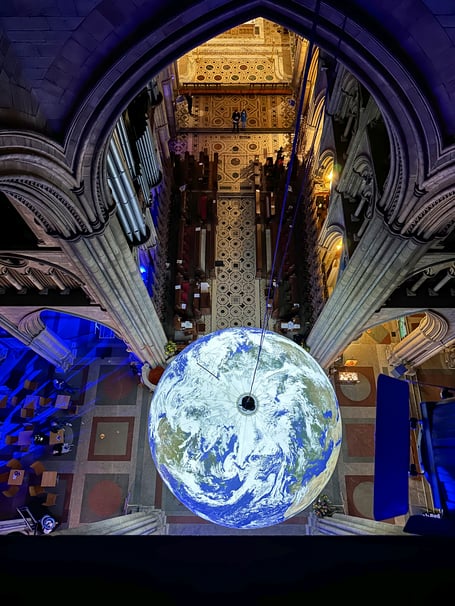A couple of weeks ago, I attended the launch night of Gaia at Truro Cathedral. Luke Jerram’s artwork, an authentic representation of Planet Earth suspended above the cathedral’s central crossing point, is every bit as spectacular and thought-provoking as you might imagine.
If you haven’t been yet, you should – even if your social media feed has been flooded with pictures, it doesn’t compare to the actual experience of being in close proximity. As Father Simon Robinson said on the night: “The cathedral is a great treasure, as is the Earth we are all part of, so this is a treasure within a treasure.”
For an unusual perspective, you are actively encouraged to lie on the floor beneath Antarctica, while others are partaking in celestial tours for the best view of the northern hemisphere. I haven’t signed up for the latter due to a fear of heights (apparently, the disclaimer points out that in the event of accident, rescue will be tricky to say the least).
I was also intrigued to see that 211m is the optimum distance for a view of Gaia as it appears from the moon. By my guesstimation, this would place you in River Street, with quite a few obstacles in between.
Art is subjective, and one chap was touring the floor showing anyone who would look a photo of Imran Qureshi’s 2016 work After which, I am no more I, and you are no more you. That collaboration between the cathedral and Newlyn Art Gallery and The Exchange saw 30,000 A1 sheets crumpled and scattered among the south aisle and spilling over rows of pews in the nave.
It was divisive at the time – it popped up in my Facebook memories a few days ago, and I commented then: “Not everyone’s cup of tea.”
I liked it, but readily admit that Gaia has wider appeal and more of a synergy with its surroundings, which is why it can also be found (spoiler alert: there’s more than one Gaia) at Bath Abbey and Lichfield Cathedral.
It’s designed to create a sense of the Overview Effect experienced by astronauts when viewing the Earth from space – a feeling of awe for the planet, a profound understanding of the interconnection of all life, and a renewed sense of responsibility for the environment.
Mounting the Gaia exhibition has cost £45,000, which will explain why staff and volunteers are exhorting regular and new visitors more urgently than usual to make cash and contactless donations, not only to pay for Gaia but to make a profit to cover the cathedral’s annual costs.
It’s a brave move, because the role of the church is also subjective. While other cathedrals – Lincoln, York, Ely – charge visitors hefty amounts to tour their interiors, Truro remains free to all.
“Quite right too – it’s a house of God,” said my mother-in-law, stoutly. That’s all very well, but there are no pennies from heaven to fix the leaks in St Mary’s Aisle.
This holy building has seen some interesting events in recent years, from silent yoga to New Year balls. Some of these seem rather hedonistic, and at odds with its core identity – I can’t help wondering whether Jesus would have placed a giant gin fair on a par with the thieves in the temple.
But I fully understand the need to raise the funds. I sit on the committee for the Cornwall Historic Churches Trust (www.chct.info), which distributes grant funding to churches of all denominations towards the Sisyphean task of maintenance work.
Some are seeking new community roles as congregations dwindle. Holy Trinity in St Austell put its pews on castors, while Bugle Chapel is selling some of its wooden seating to provide a bigger space for local groups, much to the disappointment of those who think pews are an integral (if uncomfortable) part of church life.
Cornwall Council, meanwhile, is offering to market 10 disused chapels that are no longer required for the running of the cemetery, to be repurposed and funded by “appropriate” businesses including undertakers and the creative arts (it draws the line at creches).
I’m not a believer, but I love religious buildings for their magnificent architecture and the link to our ancestors, who worshipped, socialised and celebrated there. Please remember this when you visit Gaia, and make whatever donation you can afford to keep the cathedral open for generations to come.
Gaia continues at Truro Cathedral until Saturday, October 28.





Comments
This article has no comments yet. Be the first to leave a comment.